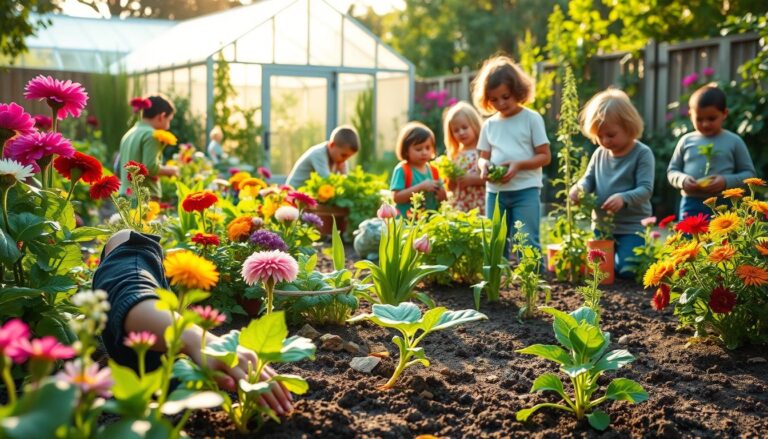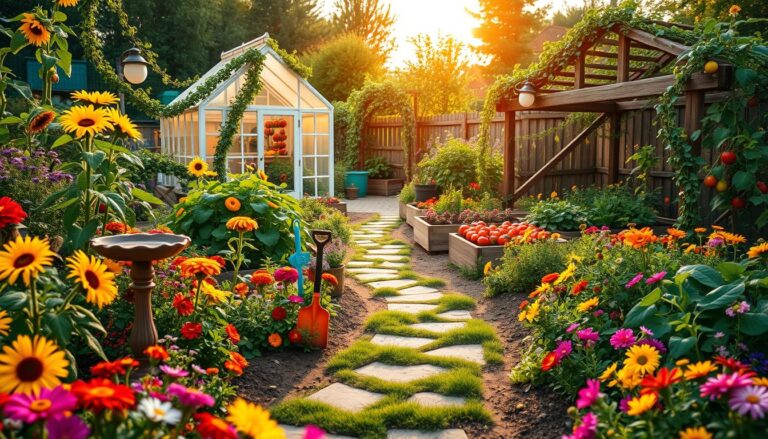Starting your journey to a thriving garden begins with understanding the basics of garden design. A well-planned garden is the foundation of a bountiful harvest.
To create a beautiful and productive vegetable garden, it’s essential to maximize yield while minimizing effort. This can be achieved by carefully planning and designing your garden layout. By doing so, you’ll be able to make the most of your space and enjoy a successful gardening experience.
With a friendly approach to gardening, we’ll guide you through the initial steps to create a stunning backyard vegetable garden. Our goal is to help you get started on your gardening journey with confidence.
The Benefits of Growing Your Own Vegetables
Growing your own vegetables is rewarding. It’s good for your health, wallet, and the planet. A well-designed vegetable garden layout is key to getting the most benefits.
Health Benefits of Home-Grown Produce
Eating fresh, home-grown veggies is healthy. They don’t have pesticides or chemicals. Using organic gardening tips can make your veggies even healthier.
Environmental Impact Reduction
Gardening at home cuts down on carbon emissions. It reduces the need for transportation and packaging of store-bought veggies. Organic gardening helps the environment too.
Financial Savings Over Time
Starting a garden costs money at first. But, it saves money in the long run. Growing your own food means less trips to the store, saving you money.
Here’s a look at the savings and benefits:
| Benefit | Initial Year | Long-Term |
|---|---|---|
| Financial Savings | $0 – $500 | $500 – $1000+ |
| Health Benefits | Improved nutrition | Long-term health advantages |
| Environmental Impact | Reduced carbon footprint | Sustainable gardening practices |
Essential Factors for Designing a Backyard Vegetable Garden
A well-planned backyard vegetable garden starts with understanding key aspects. When designing a backyard vegetable garden, several factors are crucial for a good harvest.
Evaluating Sunlight Patterns
Sunlight is vital for vegetable growth. Most vegetables need at least 6 hours of direct sunlight daily.
Full Sun vs. Partial Shade Requirements
Different vegetables need different amounts of sunlight. Tomatoes and peppers love full sun, while lettuce and spinach can handle partial shade. Knowing this helps place your vegetables right.
Tracking Seasonal Light Changes
The sunlight your garden gets changes with the seasons. It’s important to watch these changes. You might need to move plants or prune trees to adjust.
Understanding Soil Composition
Soil composition greatly affects your garden’s health. Testing your soil is a key step. Based on the results, you can add fertilizers or organic matter.
Assessing Water Access and Drainage
Good water supply and drainage are key for a successful garden. Vegetables need steady moisture, especially when fruiting. Make sure your garden has a reliable water source and drains well. Raised bed gardening can help with drainage and warming the soil.
By carefully evaluating these factors, you can create a thriving backyard vegetable garden. It will meet your needs and offer a rewarding gardening experience.
Planning Tools and Methods for Garden Design
Before you start planting, it’s crucial to plan your garden layout. Good planning makes your garden look great, work well, and last long.
Digital Garden Planning Resources
Digital tools have changed garden planning. Programs like Garden Planner and SmartDraw help you design your garden. They consider plant size, sunlight, and spacing. These tools let you see your garden before planting.
Hand-Drawn Garden Layouts
If you like old-school methods, hand-drawn layouts work well. Just use graph paper and pencils. It’s a way to add your personal touch and relax while planning.
Seasonal Planting Calendars for Your Region
Knowing when to plant is key for a good harvest. Seasonal planting calendars tell you when to plant in your area. They look at frost dates, soil temperature, and more.
| Tool | Description | Benefit |
|---|---|---|
| Garden Planner Software | Digital tool for designing garden layouts | Helps visualize garden before planting |
| Hand-Drawn Layouts | Traditional method using graph paper | Personal touch and cost-effective |
| Seasonal Planting Calendars | Guides on planting times based on region | Ensures timely planting for best yield |
Effective Vegetable Garden Layouts
A well-designed garden layout can greatly improve your gardening. The arrangement of plants, paths, and features affects how easy it is to work in the garden. It also impacts how much sunlight reaches your plants and how well they grow.
Traditional Row Garden Design
The traditional row garden design is simple and classic. It involves planting vegetables in long, straight rows. There are paths in between for easy maintenance and harvesting. This layout works best for large gardens where you might use machinery.
Square Foot Gardening Method
The square foot gardening method is efficient and saves space. It divides the garden bed into small squares, each 1 foot by 1 foot. This method helps grow many vegetables in a small area, making it perfect for small gardens.
Keyhole and Mandala Garden Patterns
Keyhole and mandala garden patterns are modern and beautiful. They use circular shapes with a central composting area or path. The beds around the path are easy to reach from the path.
“Circular garden designs not only add aesthetic value but also improve accessibility and reduce waste.”
Benefits of Circular Designs
Circular designs, like keyhole and mandala gardens, have many advantages. They make it easier to get around and reduce soil damage. The central path lets gardeners care for plants without stepping on the soil.
Accessibility Considerations
When planning your garden, think about how easy it will be to get around. Wide paths and raised beds help a lot, especially for those with mobility issues.
Choosing the right garden layout can make your vegetable garden thrive. It will meet your needs and make gardening more enjoyable.
Raised Bed Garden Designs
Using raised beds is a great way to grow a healthy vegetable garden. They offer better drainage, warmer soil, and easier access. This makes them a favorite among gardeners.
Material Options and Longevity
Choosing the right material for your raised bed is important. You can pick from wood, metal, composite materials, and recycled plastic. Each has its own benefits and drawbacks, like durability and cost.
Cedar wood is often chosen because it resists rot and insects well.
Optimal Dimensions for Easy Maintenance
The size of your raised bed matters for its use. A width of 3-4 feet is best for easy access. The length can vary, but keep it under 8 feet to avoid soil compaction.
Soil Blends for Maximum Productivity
A good soil blend is essential for a productive raised bed garden. Mix compost, peat moss, and vermiculite or perlite for structure and fertility.
Layering Techniques
Layering materials at the bottom of your raised bed helps with drainage and prevents soil erosion. Start with gravel or broken pottery, then add organic matter.
Soil Amendment Strategies
Adding regular soil amendments keeps your raised beds fertile. Use compost, manure, or green sand to replenish nutrients. Crop rotation and cover cropping also help keep the soil healthy.
By considering these tips, you can make a raised bed garden that’s both productive and sustainable. It supports your goals for sustainable home gardening.
Small Space Vegetable Garden Solutions
It’s easy to grow veggies in small spaces. A bit of creativity and the right methods can help anyone grow their own food, even in tiny areas.
Choosing the right containers is key for small space gardening. Different veggies need different containers. For example, leafy greens and herbs do well in shallow pots. But tomatoes and peppers need deeper pots for their roots.
Container Selection for Different Vegetables
Think about the plant’s size, root depth, and sunlight needs when picking containers. Here are some tips:
- Choose at least 5-gallon containers for most veggies to give them enough room.
- Look for containers with good drainage to avoid soggy soil.
- Self-watering containers can make gardening easier.
Balcony and Patio Garden Arrangements
Balconies and patios are great for small gardens if they get enough sun. Here’s how to use them well:
- Check the sun patterns to pick the right veggies.
- Use trellises or wall planters to save space.
- Group plants by their water needs to make care easier.
Maximizing Yield in Limited Areas
To get more from small gardens, try intensive planting. Plant veggies close together to use space well. Also, use organic gardening tips like crop rotation and companion planting to improve soil and fight pests.
Other ideas include vertical gardening and picking compact or dwarf varieties of veggies. These are made for small spaces.
Urban Gardening Ideas for Limited Spaces
Gardening in the city might seem impossible, but it’s not. You can grow a great vegetable garden, even with very little space. Urban gardening has its challenges, but there are many creative ways to garden in small areas.
Rooftop Garden Considerations
Rooftop gardens are a great choice for city gardening. Before starting, check the roof’s weight limit, drainage, and wind protection. Using lightweight containers and soil helps with weight. Drainage mats keep the soil from getting too wet.
Community Garden Participation
Community gardens are another good option. They offer a place to garden and a community to connect with. To start, find local community gardens and ask about plots and rules.
Window Box and Indoor Growing Systems
If you have very little space, consider window boxes or indoor systems. Window boxes fit on balconies or windowsills. Indoor systems like hydroponics or aeroponics grow plants all year. LED grow lights help plants get enough light.
| Gardening Method | Space Requirement | Initial Investment |
|---|---|---|
| Rooftop Garden | High | Moderate to High |
| Community Garden | Variable | Low to Moderate |
| Window Box | Low | Low |
| Indoor Growing Systems | Low | High |
These urban gardening ideas let you grow your own food, even in tiny spaces. Choose from rooftop gardens, community gardens, window boxes, or indoor systems. There’s a perfect fit for everyone.
Vertical Growing Techniques
Vertical growing techniques can greatly boost your vegetable garden’s productivity. They’re perfect for those with little space, as they make the most of every inch.
Trellis and Support Structure Options
Trellises and support structures are key for vertical gardening. You can choose from wood, metal, or plastic, based on durability, cost, and looks. A wooden trellis adds a natural touch, while metal offers a sleek look.
Wall-Mounted Growing Systems
Wall-mounted systems are great for vertical gardening. They fit well in small gardens or city spaces. These systems have pockets for plants, letting you grow many types of veggies.
Best Climbing Vegetables for Vertical Gardens
Some veggies are perfect for vertical gardens. Peas, beans, and cucumbers love climbing up. Tomatoes and squash can also grow vertically with the right support.
Vine Management Strategies
Managing vines is key for a successful vertical garden. Train vines to climb and prune them regularly. This helps them grow well and produce more.
Weight and Support Considerations
Think about the plants’ weight and the support’s strength when planning your garden. The structure must hold the plants, especially when they’re full of fruit.
| Vegetable | Support Needed | Yield Potential |
|---|---|---|
| Peas | Trellis or netting | High |
| Tomatoes | Sturdy stake or cage | Very High |
| Cucumbers | Trellis or cage | High |
Using vertical growing in your vegetable garden layout makes it more productive and diverse. It’s especially good for small spaces. Adding raised bed gardening can make your garden even better in yield and looks.
Companion Planting for Garden Success
By pairing plants wisely, gardeners can make their gardens more balanced and productive. This method, called companion planting, is a key organic gardening tip. It helps your vegetable garden grow better and stronger.
Companion planting means growing different plants together to boost their health and growth. Some plants help keep pests away, attract good bugs, and even make the soil better.
Beneficial Plant Combinations
Some plant pairs are especially good. For example, marigolds with tomatoes can keep nematodes away. Basil keeps aphids off and makes nearby veggies taste better. The “Three Sisters” method is another great example. It pairs corn, beans, and squash to help each plant grow better and fight pests.
Natural Pest Deterrent Plantings
Some plants naturally keep pests away, cutting down on the need for harmful chemicals. Garlic and chives, for instance, can keep aphids and other pests from vegetables.
Plants to Keep Separated
Not all plants should be grown together. Some can actually harm each other. For example, growing broccoli and cauliflower near tomatoes can make them more likely to get sick. Knowing which plants to keep apart is key to a healthy garden.
| Plant Combination | Benefit |
|---|---|
| Marigolds & Tomatoes | Deter nematodes |
| Basil & Vegetables | Repel aphids, improve flavor |
| Corn, Beans, & Squash | Symbiotic growth, reduced pests |
Edible Landscaping Integration
A well-designed edible landscape is a feast for the eyes and the table. It combines beauty and productivity. Edible landscaping is more than growing food; it’s about creating a space for relaxation and enjoyment.
Ornamental Vegetables in Garden Design
Ornamental vegetables add color, texture, and interest to your garden. Plants likerainbow chardandred lettuceare beautiful and edible. They’re perfect for salads or meals.
Herb and Vegetable Border Ideas
Herb and vegetable borders define garden areas. For example, lavenderorrosemary borders add fragrance and beauty. Leafy greens likekaleorspinach borders offer a nutritious harvest.
Incorporating Fruit-Bearing Plants
Fruit-bearing plants likestrawberries,blueberries, anddwarf citrus trees add variety and productivity. They can be used in borders, containers, or as focal points.
| Plant Type | Example Varieties | Uses in Garden Design |
|---|---|---|
| Ornamental Vegetables | Rainbow Chard, Red Lettuce | Colorful borders, container gardens |
| Herbs | Lavender, Rosemary | Fragrant borders, companion planting |
| Fruit-Bearing Plants | Strawberries, Blueberries, Dwarf Citrus | Focal points, borders, containers |
By integrating edible plants into your garden design, you create a space that’s both beautiful and productive.
Sustainable Home Gardening Practices
Sustainable gardening is key to reducing your garden’s impact on the environment. It helps keep your garden healthy and productive. By using eco-friendly methods, you can make your garden a win-win for you and the planet.
Water Conservation Design Elements
Water conservation is vital in gardening. Using efficient irrigation systems can cut down on water waste.
Drip Irrigation Setup
Drip irrigation sends water straight to plant roots. This cuts down on evaporation and runoff. It’s great for vegetable gardens.
Rainwater Collection Systems
Setting up a rainwater collection system lets you save rainwater for later. This reduces your need for city water.
| Water Conservation Method | Description | Benefits |
|---|---|---|
| Drip Irrigation | Delivers water directly to plant roots | Reduces evaporation and runoff |
| Rainwater Collection | Harvests and stores rainwater for use | Decreases municipal water usage |
Composting Areas and Systems
Composting is essential for sustainable gardening. It turns waste into a valuable resource. This way, you can make soil rich in nutrients that helps plants grow well.
Natural Pest Management Zones
Creating zones for natural pest control means planting a variety of plants. These plants keep pests away without using harmful chemicals. This method protects your veggies and helps the ecosystem stay balanced.
By using these sustainable gardening practices, you can have a productive and eco-friendly garden. It’s all about making choices that help your garden and the environment.
Conclusion: Creating Your Dream Vegetable Garden
Creating a backyard vegetable garden needs careful planning and using sustainable practices. Think about sunlight, soil, and water access. This way, you can make a garden that grows well and meets your needs.
A good garden design makes your outdoor space better. It also gives you fresh food, helps the environment, and saves money. Whether you’re new to gardening or have experience, this article’s tips can help you succeed.
Using sustainable methods like saving water and composting makes your garden better for the planet. With these tips, you’re set to start or keep up your gardening journey. Enjoy the joy of growing your own veggies.
FAQ
What are the key elements to consider when designing a backyard vegetable garden?
How can I maximize yield in a small space vegetable garden?
What are the benefits of raised bed gardening?
How can I incorporate edible landscaping into my garden design?
What are some sustainable home gardening practices I can adopt?
How can I plan my garden effectively?
What are some effective vegetable garden layouts I can consider?
How can I manage pests naturally in my garden?

Sortemdia nasceu com o propósito de trazer alegria e oportunidades para todos por meio de sorteios gratuitos de prêmios incríveis. O site tem como missão oferecer experiências acessíveis, divertidas e justas para quem deseja concorrer a produtos, serviços e brindes sem pagar nada por isso. Acreditamos que a sorte pode bater à porta de qualquer pessoa — e no Sortemdia, ela pode chegar com apenas um clique.



